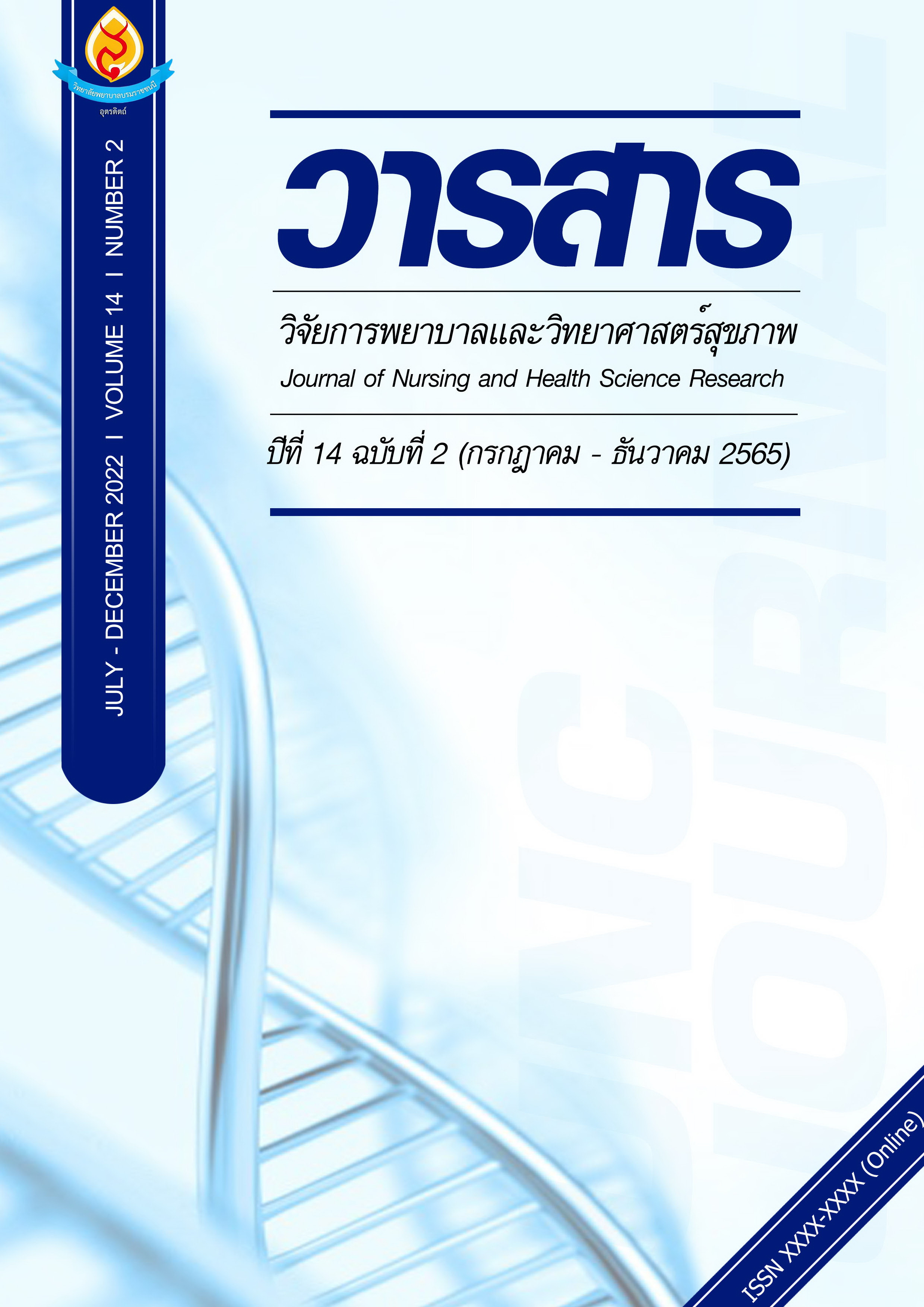ปัจจัยทำนายภาระของผู้ดูแลผู้สูงอายุพาร์กินสันในแผนกผู้ป่วยนอก
Main Article Content
บทคัดย่อ
บทความวิจัยนี้เป็นการวิจัยเชิงพรรณนา มีวัตถุประสงค์เพื่อศึกษาภาระของผู้ดูแลผู้สูงอายุพาร์กินสันและปัจจัยทำนายภาระของผู้ดูแลผู้สูงอายุพาร์กินสัน ได้ทำการสุ่มตัวอย่างแบบเจาะจงในกลุ่มผู้ดูแลผู้สูงอายุพาร์กินสัน จำนวน 147 คน ได้รับคัดเลือกที่แผนกผู้ป่วยนอก รวบรวมข้อมูลด้วยแบบสอบถามประกอบด้วย 2 ส่วน ได้แก่ แบบสอบถามข้อมูลทั่วไปของผู้สูงอายุพาร์กินสันและผู้ดูแลผู้สูงอายุพาร์กินสัน และแบบสอบถามภาระในการดูแลผู้ป่วยเรื้อรัง วิเคราะห์ข้อมูลโดยสถิติเชิงพรรณนาและการวิเคราะห์การถดถอยพหุคูณ
ผลการศึกษาพบว่าผู้ดูแลผู้สูงอายุพาร์กินสันรับรู้ภาระในการดูแลโดยรวมอยู่ในระดับน้อย โดยมีคะแนนเฉลี่ยเท่ากับ 27.30 คะแนน ภาระของผู้ดูแลผู้สูงอายุพาร์กินสันเมื่อแบ่งตามระดับภาระของผู้ดูแลผู้สูงอายุพาร์กินสันพบว่า ในภาพรวมมีคะแนนเฉลี่ยเท่ากับ 27.30 คะแนน แบ่งเป็นระดับพบว่าส่วนใหญ่ผู้ดูแลผู้สูงอายุพาร์กินสันรู้สึกเป็นภาระการดูแลระดับน้อยร้อยละ 39.45 รองลงมาไม่รู้สึกเป็นภาระการดูแลร้อยละ 34.69 รู้สึกเป็นภาระการดูแลระดับปานกลางร้อยละ 24.44 และรู้สึกเป็นภาระการดูแลระดับมากร้อยละ 1.42 ตามลำดับ เมื่อศึกษาปัจจัยทำนายพบว่า อาชีพและระดับของความเจ็บป่วยของผู้ป่วยและอาชีพของผู้ดูแล สามารถร่วมกันทำนายภาระของผู้ดูแลผู้สูงอายุพาร์กินสันได้ ร้อยละ 42.6 อย่างมีนัยสำคัญทางสถิติที่ระดับ .001 (R2 = .426) โดยพบว่าระดับของความเจ็บป่วยเป็นตัวแปรที่ร่วมทำนายภาระของผู้ดูแลผู้สูงอายุพาร์กินสันได้มากที่สุด (Beta = .304, p < .000) รองลงมาคือ อาชีพของผู้ป่วย (Beta = .285, p < .000) และอาชีพของผู้ดูแล (Beta = .267, p < .011) โดยการศึกษานี้สามารถนำไปเป็นข้อมูลพื้นฐานในการวางแผนและพัฒนารูปแบบในการลดภาระการดูแล และส่งเสริมความสามารถในการเป็นผู้ดูแลผู้สูงอายุที่เป็นโรคพาร์กินสันได้
Article Details

อนุญาตภายใต้เงื่อนไข Creative Commons Attribution-NonCommercial-NoDerivatives 4.0 International License.
บทความหรือข้อคิดเห็นใดใดที่ปรากฏในวารสารวิจัยการพยาบาลและวิทยาศาสตร์สุขภาพ เป็นวรรณกรรมของผู้เขียน ซึ่งบรรณาธิการหรือสมาคมศิษย์เก่า ไม่จำเป็นต้องเห็นด้วย และบทความที่ได้รับการตีพิมพ์เผยแพร่ถือเป็นลิขสิทธิ์ของวารสารวิจัยการพยาบาลและวิทยาศาสตร์สุขภาพ
เอกสารอ้างอิง
Bhidayasiri, R. (2007). Clinical Practice guideline for diagnosis and management of Parkinson’s disease: excellence center for Parkinson’s disease and abnormal movement King Chulalongkorn Memorial Hospital. (in Thai).
Bhidayasiri, R. (2017). Excellence center for Parkinson’s disease and abnormal movement King Chulalongkorn Memorial Hospital. Retrieved (2020, November 25). from http:// www.chulapd.org/uploads/download_list/4/a-04.pdf. (in Thai).
Kunyodying, T., Pothiban, L. & Khampolsiri, T. (2015). Dependency of the elderly with stroke, caregiver burden, social support, and quality of life among older caregivers. Nursing Journal, 42(Supple ment), 107-117. (in Thai).
Klanbut, S., Phattanarudee, S., & Bhidayasiri, R. (2019). Autonomic dysfunctions in patients with Parkinson’s disease. Thai Journal of Pharmacy Practice, 11(2), 455-456. (in Thai).
Lertrat, P., Panpruek, W., & Tiamkao, S. Factors affecting burden on caregivers of older persons with parkinson’s disease at outpatient department. Journal of Nursing Science & Health, 38(3), 86-98. (in Thai).
Luweera, W. (2013). Health care of palliative caregivers. Srinagarind Medical Journal, 28(2), 266-270. (in Thai).
Martinez-Martin, P., Rodriguez-Blazquez, C., & Forjaz, M. J. (2014). Quality of life and burden in caregivers for patients with Parkinson’s disease: concepts, assessment and related factors. Expert Review of Pharmacoeconomics & Outcomes Research, 12(2), 221-230.
Maserejian, N., Vinikoor-Imler, L., & Dilley, A. (2020). Estimation of the 2020 Global Population of Parkinson’s Disease (PD). Retrieved (2020, November 21) from https://www.mdsabstracts.org/abstract/estimation-of-the-2020-global-population-of-parkinsons-disease-pd/
National Alliance for Caregiving, & American Association of Retired Person. (2020). Caregiving in the U.S. Retrieved (2020, November 21) from http://www.cargiving.org/data/Caregiving_in_the_US_2020_full_report.pdf.
Peachpunpisa, C. (2015). Caregiver in Parkinson’s disease Patient. Journal of Phrapokklao Nursing College, 26(1), 111-116. (in Thai).
Pongwarin, N. (2010). Parkinson Disease. Retrieved (2020, November 27) fromhttp://www.si.mahidol.ac.th/sidoctor/e-pl/articledetail.asp?id=112. (in Thai).
Pranin, W., Lertrat, P., Punpruek, W., & Tiamkao, S. (2015). Factors affecting burden on caregiver of older people with Parkinson’s disease in out patient department. Journal of Nursing Science & Health, 38(3), 86-98. (in Thai).
Tessitore, A., Marano, P., Modugno, N., Pontieri, F. E., Tambasco, N., Canesi, M., ... & Antonini, A. (2018). Caregiver burden and its related factors in advanced Parkinson’s disease: data from the PREDICT study. Journal of neurology, 265(5), 1124-1137.
Thamomseng, N. (2018). Sample size determination. Retrieved (2022, November 26) from https://home.kku.ac.th/nikom/516201_sample_size_nk2561.pdf. (in Thai).
Toonsiri, C., Sunsern, R., & Lawang, W . (2011). Development of the burden interview for caregivers of patients with chronic illness. Journal of Nursing and Education, 4(1), 62-75. (in Thai).
Zarit, S. H., Todd, P. A., & Zarit, J. M. (1987). Subjective burdens of husbands and wives as caregivers: a longitudinal study. Alzheimer Disease & Associated Disorders, 1(2), 109-110.


